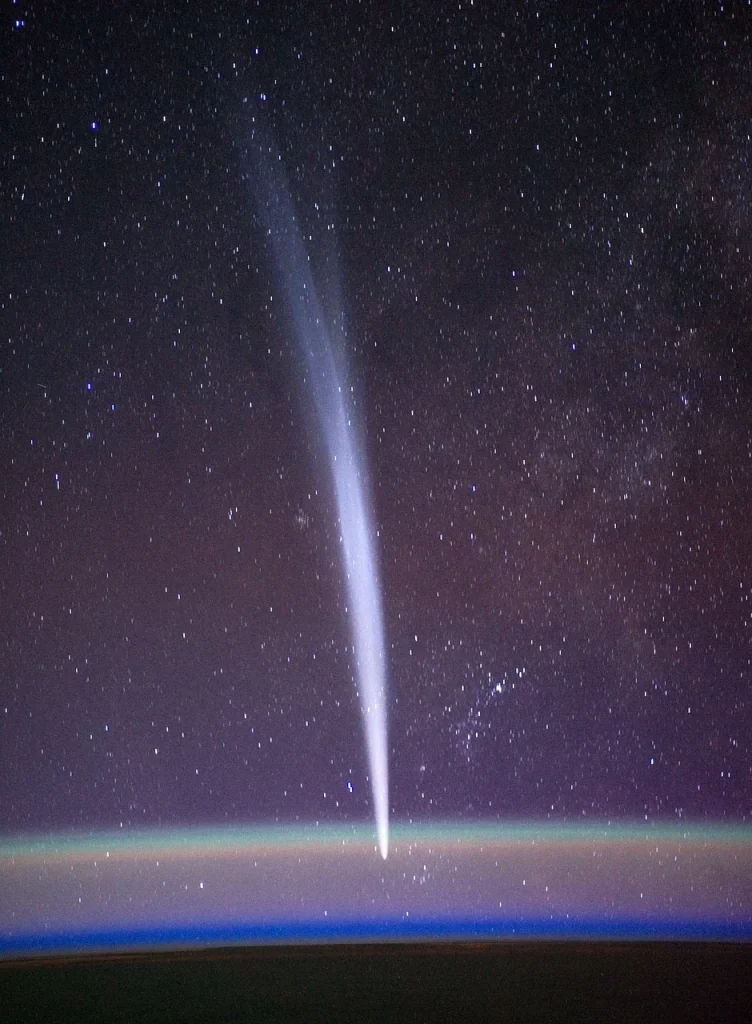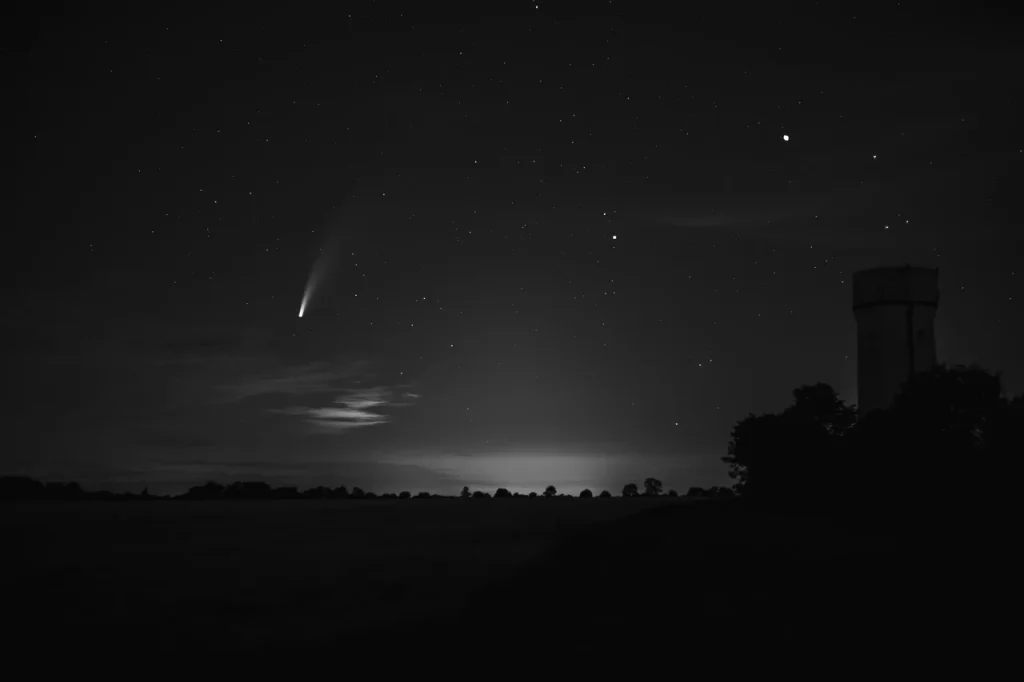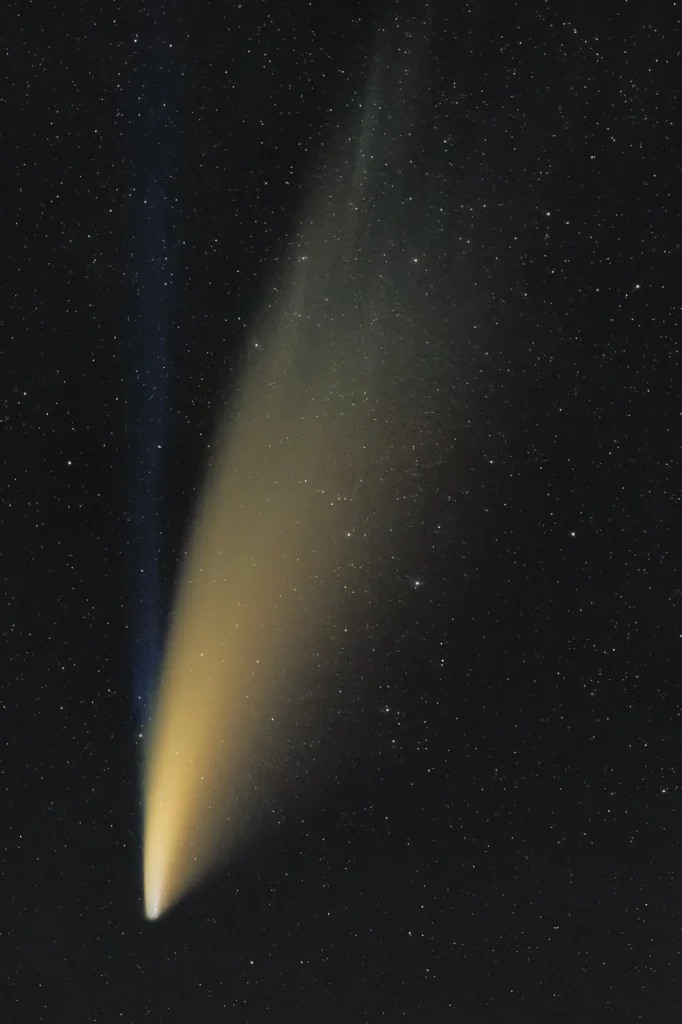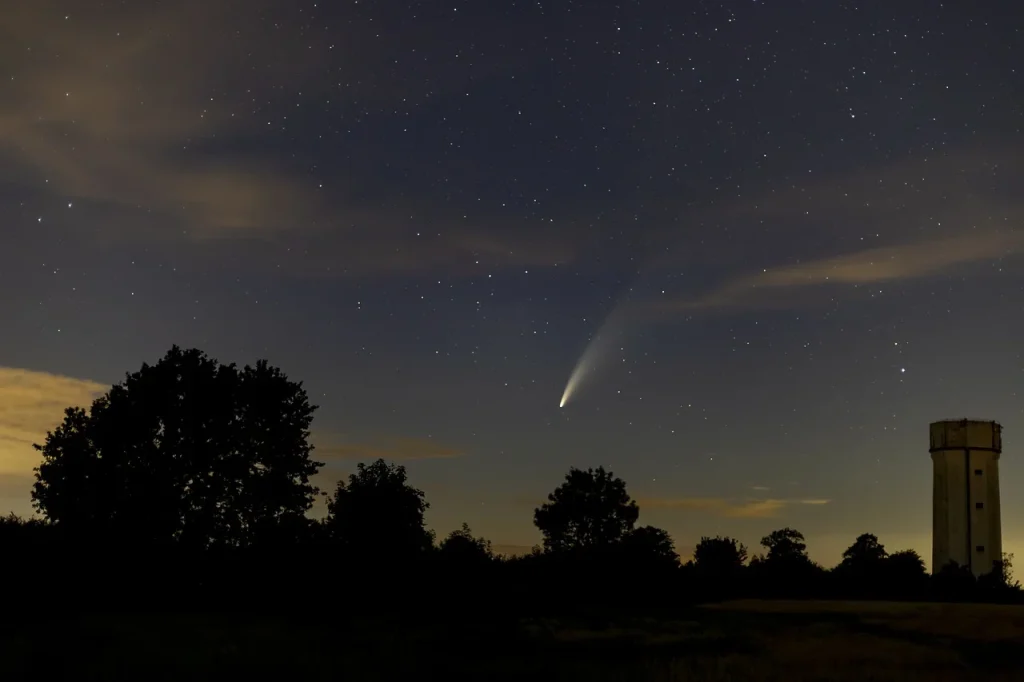What exactly are those bright, glowing objects with long tails that occasionally grace our night skies? These are comets, ancient travelers from the outer reaches of our solar system. They have been a source of wonder and mystery for generations.
In this article, we’ll explore some interesting facts about comets, shedding light on their origins, behavior, and the remarkable phenomena they create. From their icy cores to their spectacular tails, you’ll discover why comets continue to captivate our imagination.
A comet is a broom that sweeps the sky.
Thomas Carlyle
Comet Facts
Comets have fascinated humanity for centuries with their mysterious glow and spectacular tails. Read on to uncover the facts about these celestial wanderers, and be sure to pay attention—there’s a quiz at the end to test your comet expertise!
- Some small icy bodies in the outer solar system get knocked into eccentric orbits that bring them close to the Sun.
- The Sun’s heat can cause a dramatic outburst, resulting in the sudden brightening of these celestial objects.
- Halley’s appearance every 76 years allows multiple generations to witness its spectacular display.
- The Great Daylight Fireball of 1972 was an Earth-grazing object that skipped off the atmosphere and returned to space.
- Deep Impact, a NASA mission, deliberately collided with Tempel 1 to study its composition.
- Some celestial wanderers have hyperbolic orbits, indicating they come from interstellar space.
- These icy bodies are remnants from the solar system’s formation over 4.6 billion years ago.
- The Oort Cloud is a spherical shell of icy bodies far beyond Pluto’s orbit, containing trillions of these objects.
- When close to the Sun, solar radiation causes sublimation, forming a glowing coma and tail.
- Chiron, discovered in 1977, is a hybrid body with characteristics of both asteroids and these icy objects.
- Halley has appeared in historical records for over 2,000 years, with its next appearance in 2061.
- The Stardust mission returned samples of dust from Wild 2 to Earth for analysis.
- Hale-Bopp, one of the brightest in history, was visible to the naked eye for 18 months in 1996-1997.

- The nucleus, typically only a few kilometers across, can produce tails millions of kilometers long.
- Jets of gas and dust can create multiple tails pointing in different directions.
- The Giotto spacecraft flew by Halley in 1986, providing the first close-up images of its nucleus.
- Their tails always point away from the Sun, due to the solar wind and radiation pressure.
- Some tails contain complex organic molecules, which could shed light on the origins of life.
- The Rosetta mission orbited and landed a probe on 67P/Churyumov-Gerasimenko in 2014.
- Comet Shoemaker-Levy 9 spectacularly collided with Jupiter in 1994, providing valuable data.
- Their activity can reveal clues about the early solar system’s conditions.
- Comet tails can extend across vast distances, sometimes even crossing Earth’s orbit.
- Outgassing can cause a rapid increase in brightness, known as a “cometary outburst.”
- Oumuamua, an interstellar visitor, exhibited characteristics of both asteroids and these icy bodies.
- Cometary dust particles are often as fine as cigarette smoke and can travel at high speeds.
- The chemical composition of these bodies can include water, carbon dioxide, methane, and ammonia.
- Some can have a rocky surface covered by a thin layer of volatile ices.
- Their nuclei are often irregularly shaped, resembling “dirty snowballs.”

- Their activity can lead to the formation of meteor showers when Earth passes through their debris.
- Halley’s debris stream causes the annual Orionid meteor shower each October.
- Their orbits can be highly elliptical, taking them from the distant Oort Cloud to close passes by the Sun.
- Some comets can have periodic orbits, returning to the inner solar system at regular intervals.
- When approaching the Sun, they lose mass due to sublimation, reducing their size over time.
- Some can split into multiple fragments, creating spectacular displays of multiple nuclei.
- Solar wind and radiation pressure can create distinct ion and dust tails.
- Comets can provide important clues about the presence of water and organic molecules in the early solar system.
- Some researchers speculate that impacts from these objects may have delivered water and organic materials to Earth.
- Their orbits can be altered by gravitational interactions with planets, changing their paths significantly.

- Cometary nuclei are typically covered in a dark, carbon-rich crust that reduces their reflectivity.
- Some comets have been observed to disintegrate completely as they pass close to the Sun.
- Their tails can exhibit complex structures, including streamers and knots, influenced by solar wind variations.
- Observations of comets have revealed the presence of noble gases like argon and xenon.
- Their activity can lead to the formation of temporary atmospheres, or “coma,” around their nuclei.
- Some cometary orbits are inclined at steep angles to the plane of the solar system, indicating past gravitational interactions.
- Comet Encke has the shortest known orbital period, returning every 3.3 years.
- Observations of comets can help astronomers understand the dynamics and evolution of the solar system.
- Their nuclei can contain “trapped” ancient material, preserving the conditions of the early solar system.
- Their tails can reach lengths of up to 100 million kilometers, far exceeding the distance between Earth and the Moon.
- Close encounters with planets can eject comets from the solar system or send them into the Sun.
- Cometary nuclei can harbor complex organic compounds, potentially important for the development of life.
Comet Myths

Having explored the facts, let’s now turn to the myths. We’ll debunk these misconceptions and clarify what’s true.
- Comets are stars with tails.
They are often mistaken for stars due to their bright appearance and trailing tails, but they are actually composed of ice, dust, and rocky material. As they approach the sun, their surfaces are heated, causing them to release gases and dust that form the glowing tail. - Comets bring bad luck and disaster.
Throughout history, they have been viewed superstititiously as omens of doom. However, no credible evidence supports the belief that comets influence events on Earth. They are simply natural phenomena governed by the laws of physics. - A comet’s tail burns because it is on fire.
It is commonly misunderstood that a comet’s tail is ablaze. Instead, the tail is formed when the sun’s radiation causes the comet’s ice to sublimate and the solar wind pushes this material away from the comet, creating a stream that reflects sunlight. - Comets are solid, rocky bodies like asteroids.
While both comets and asteroids are celestial bodies within our solar system, comets are distinct because they possess a nucleus made of ice and rock. When near the sun, the ices are vaporized, displaying a characteristic coma and tail, unlike solid asteroids. - The tails of comets always trail behind them in space.
The orientation of a comet’s tail is not determined by the comet’s direction of travel but rather by the solar wind. The tail is always pushed away from the sun regardless of the comet’s trajectory through space.
Comet Quotes

Explore these quotes from thinkers and observers who sought to capture the comet’s essence. Feel free to share more in the comments and I will add them to the list.
I came like Water, and like Wind I go.
Omar Khayyam
Omar Khayyam, a Persian mathematician and poet, likened his transient, fleeting life to natural elements, evoking the swift passage of a comet.
Comets are like cats: they have tails, and they do precisely what they want.
David H. Levy
David H. Levy, an astronomer known for co-discovering Comet Shoemaker-Levy 9, humorously compares the unpredictable nature of comets to that of cats.
Comets importing change of times and states, brandish your crystal tresses in the sky.
William Shakespeare
Shakespeare, in his play “Henry VI,” uses the appearance of a comet as a dramatic symbol of impending change and turmoil.
If you want to be a comet hunter, go out there and look where no one else is looking.
David H. Levy
Once again, David H. Levy offers practical advice for aspiring astronomers, emphasizing the importance of exploring uncharted territories.
My career was sputtering until I did a 360 and got headed in the right direction.
Tracy McGrady
While not explicitly about comets, Tracy McGrady, a former professional basketball player, uses a metaphor suggesting a sudden, comet-like reversal in his career trajectory.
Comet FAQ

As we move into the final section before our quiz, it’s crucial to focus on the upcoming FAQs. Read carefully if you want to score a perfect ten.
- What is a comet?
A comet is a small celestial body that orbits the Sun, made of ice, dust, and rocky material. When it comes close to the Sun, it heats up and releases gases, creating a glowing coma (the fuzzy outline) and sometimes a tail that streams away from the Sun. - How do comets get their tails?
As a comet approaches the Sun, its icy core heats up and releases dust and gases, forming a glowing head known as the coma. The solar wind (a stream of charged particles from the Sun) pushes this material into a tail that extends away from the Sun. - Are comets and asteroids the same?
No, they’re quite different. While both are celestial bodies that orbit the Sun, comets are composed of ice and dust which can create a tail as they near the Sun. Asteroids, on the other hand, are mostly rocky or metallic and do not typically form tails. - What is the difference between a comet’s ion tail and dust tail?
A comet usually has two tails: an ion tail and a dust tail. The ion tail, made of gases, always points directly away from the Sun because it’s blown by the solar wind. The dust tail, made of larger particles, trails behind the comet in its orbit and is curved a bit because of the comet’s movement. - How often do comets visit the inner solar system?
It varies greatly. Some comets have short orbital periods of a few years while others might not return for hundreds or even thousands of years. The famous Halley’s Comet, for instance, returns every 76 years.
Comet Trivia

Welcome to the Cosmic Comet Quiz! Remember, if you miss all the questions, you’ll be demoted to Pluto—no longer a planet, and neither will you be a quiz star!
Conclusion
Comets, those icy architects of the sky, have dazzled us with their brilliance and mystery. From sparking wonder and superstition in ancient civilizations to advancing modern science, these celestial wanderers have a unique place in the cosmos.
Their visits, though fleeting, are powerful reminders of the dynamic and ever-changing universe we are a part of. So next time a comet graces our sky, step outside, look up, and enjoy the cosmic show! Till next time, stay curious and explore more. Cheers.
8 Sources Used For This ArticleHalley’s Comet – Wikipedia
Comets: All About Comets in Our Solar System – Planet Seducation
Trivia Quiz On Comets And Meteorites – Proprofs
Comet Facts: Key Insights – Living Cosmos
Comets – Khadley
Comets Introduction – Planets For Kids
Asteroid vs Comet: Difference and Comparison – Ask Any Difference


